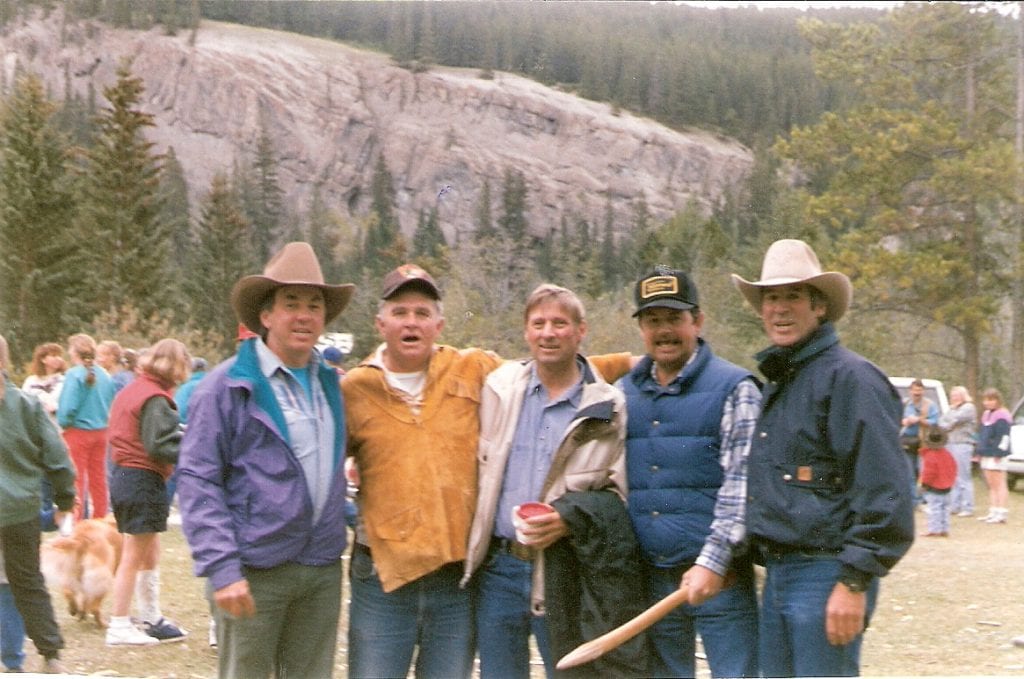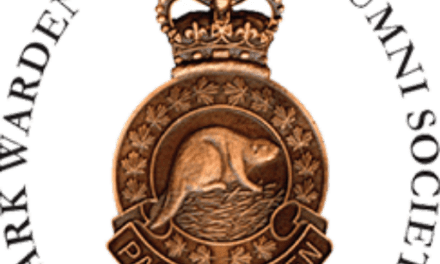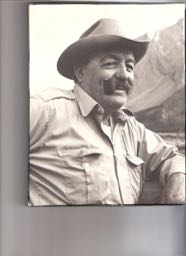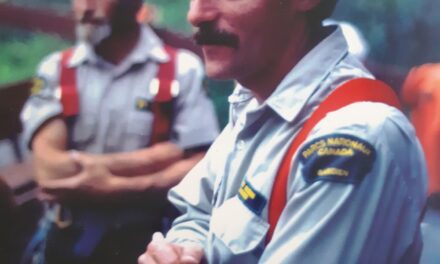(53:18) Then that spring which would be 1994, I was going to come back to work. I came back to work technically at the end of 1993. My year off was over with. So I worked that winter. Then I wanted to do a trip. I wanted to start a business taking tourists to China. I had been there in 1985. I went with Kathy’s dad Don Forest. Just the two of us went over there and spent a month in China. I found somebody that could put together the trips for me and whatnot. Of course China was just now in this transition of becoming (a more mixed economy). Construction was just taking off in China. We had been there in 1985 and there were no vehicles on the road. You show up again in 1994 and the roads are choked full of lorries, cars and everything else. All the bikes and carts were trying to look out for themselves on the side of the road. So we found somebody that could put together (trips) and look after us…I did three tours to China, taking time off and this sort of thing. Kathy and I did.
(54:45) When I returned to work I had given up on the dog position and I just went in to general warden duty stuff and I wasn’t really happy. I was trying to fit into being just the duty warden and the mundane aspect of that, didn’t really go over that well for me. At the same time there was a lot going on in Parks Canada that was negative and they were going through this whole corporate restructuring thing. Mission statements and choosing your destiny documents. People were wandering around like they had drunk the kool-aid, mumbling mission statements and the buzz words. I had come back from my year off and all these people looked like zombies to me. I am going, “What the hell happened to this outfit? I have only been gone a year.” Then I decided that I just couldn’t sit back and not do anything, so I started to write letters to the Jasper Fitzhugh (newspaper) and the Crag and Canyon. I remember in 1996 it was, I had written a letter in both newspapers that really challenged what they were doing as far as the organization was concerned and the fact that this was side tracking so many people from doing what they should be doing, as far as work was concerned. To run a national park or to run a national parks service. That didn’t go over very well with Donna Petrachenko…Of course there was this big thing about, “Who is this person and why is he doing this?” You know that you are not allowed to do this because there is a gag order on everything. There was this major discussion which went on. The Chief Warden at that time was Paul Galbraith and I wasn’t getting along with anybody that was above me…I was challenging everybody. It was just a difficult period for everybody. I remember they had to decide what they were going to do as far as firing me was concerned. I went to the union and I said, “Look it, I think that they are probably looking at trying to fire me over this whole thing.” So the union actually really came to bat for me. We went into a meeting with Paul Galbraith over the letter and he is going, “Why did you write the letter? Why didn’t you come to me?” “Well, what are you going to do? You know somebody has to say something here and I’ve stepped out and done it and now I am paying the consequences I guess.” They…wanted to do something from a discipline standpoint. They decided that they weren’t going to fire me. But the head of the PSAC (Public Service Alliance of Canada) in Ottawa had told the union in the park that “Whatever this Dale Portman has done he better start toning things down.” Of course at this point I am looking at getting out of the outfit anyway. It is not going the way I would like it to go and I am being critical. So it is not a good situation. Anyways they couldn’t do anything. The union went to bat for me and they backed down. But I was kept on a pretty tight rein after that. I was told not to write anymore articles in the local paper. I was now thinking about putting some of my stories together and doing that aspect of things through a writing standpoint. So I started doing some of that and just kind of getting by as far as being a duty warden was concerned. Then I took the first opportunity…when they were buying people out and I went. I went just before I was 50 years old…It allowed me to protect my pension. I left in 1998. I continued working with the horse supported hiking trips. I got really involved with that even more.
(1:00:10) Then in 1999, we had decided to move to Calgary. We had a house that we bought in Jasper and we were doing a bed and breakfast out of it. But to make the code we had to put in a lot of money into this house, so we decided that it wasn’t worth it. The houses in Jasper were pretty expensive and we had a big mortgage. It made sense to move to Calgary and find something there, so that is what we did. We moved to Calgary in 1999 and you (Kathy) retired in 1999.
(1:00:55) When I look back at my career in the warden service the thing that stands out the most to me is the backcountry. It was just so important to all of us who ever did anything back there and to see what has happened to the national parks now for Banff, Jasper, Yoho and Kootenay it is hard. You know, really it is. But we had the best time. We were wardens, at kind of the golden period. What Kathy and I did once we retired was we volunteered to go back in Jasper for two weeks at a time and do work. On the north boundary, south boundary repairing hitching rails, fixing corrals, painting cabins and whatnot. We did that for about ten years, until finally a couple of years ago it was getting so bad with what was going on with Parks that they didn’t want any of us back there. Because then we were another set of eyes and ears… and they don’t have any coverage back there anyways.
(1:02:11) Kathy – And they don’t have any gag order on us.
(1:02:19) Dale – Of course the mountain rescue part of it was always something that really kept us together as a group. It gave us a bit of an Esprit de Corps. But not just the public safety because you know riding around in the backcountry with two pack horses and a saddle horse that in itself is pretty neat. I think they looked at the warden service as being difficult because we challenged a lot on environmental issues. This whole thing that came up with regard to the handguns was just a convenient thing for them to use to get rid of the warden service. Of course now you can see that if the warden service was still in place in our western parks we would be putting up a big fuss and fight over what has happened and how they are running the parks now. They didn’t need that…The warden alumni has been something that has been quite fruitful for all of us. It has really worked well because all of us are in the Bow Corridor, this is where the concentration of a lot of mountain wardens live – Canmore, Cochrane, Banff. That has been quite fulfilling from our standpoint. Then of course the big centennial celebration of 2009 was a good way to kick off the end of the warden service. That really was quite successful from a financial standpoint as well as from an organizational standpoint.

Warden Days in Jasper National Park 1993
Brian Wallace, Gordon McClain, Al Stendie, Gord Anderson and Dale Portman
Photo courtesy of Gordon McClain
(1:05:32) Kathy – I was born in Edmonton in 1947. It was quite a shock to my parents because I wasn’t supposed to be one of the kids. I have a twin brother and they didn’t know that my mother was having twins until she actually had them! Dad had brought one set of clothing and they were running around trying to find more clothing. But it was a bit traumatic because twins were often early, premature. We were premature and I was kind of the weak one. I think I was about a pound and a half or so. I spent the first couple of months in an incubator. But, I survived and came home eventually.
(1:06:35) It was interesting growing up. My father…was a very progressive man at the time. My mother was pretty conventional, but she basically provided a very good home. But anyway, my dad thought, “Okay I’ve got a boy and a girl. So I am going to bring them up the same.” Which was very unusual. The thing that formed probably what I did in life afterwards was we had a farm out in Saskatchewan. My grandparents farm and my brother and I spent quite a lot of time there. We were always running outside playing, riding horses and swimming. It was a great childhood that way. My mother also said that on the weekend she wanted to have time to herself. So she more or less told dad that he would be looking after us on the weekends. Dad was an avid hunter and fisherman, he also camped and stuff like that. But mostly hunting. Anyway he would take us with him, even though we were quite young. I think the first time I went out with him and he was hunting rabbits we were two years old. I remember him putting us on this box and he wondered why were crying when he came back with this rabbit. We were sitting on an ant pile. We didn’t move. He had some very unique ways of babysitting. He would employ trees, haystacks, mostly haystacks and trees. So he would go hunting with my uncle and he would put us on these big haystacks and we couldn’t get down. It was warm and we could hear them out there hunting away. Trees were great because we couldn’t get down… I have this very vivid memory of sitting there with my brother on this limb watching and it was just amazing how many animals came by, foxes and all kinds of things. He was quite a birder so we learned (all out birds). We grew up in a very natural environment.
(1:09:18) At 12, it was actually illegal at this time, but he gave us our first shotguns. We had already started working with 22s and we were shooting gophers. We were brought up like farm kids. I remember getting this 12-guage shotgun and the first time I fired it, I flew back into the ditch! But my brother’s name was Ken and dad saved money by getting a hunting license for K. Forest. And back then, it was just a sign of the times, nobody asked what your sex was, you didn’t have to put down whether you were a male or a female on a hunting license. They just assumed that women don’t hunt. And I grew up being able to ride, we had big farm horses. We had a wonderful time. We would go out and catch the horses and ride all over the place.
(1:10:32) I think I was 13 or 14 when we moved to Calgary. It suddenly became apparent that my dad was really interested in climbing. We were just doing a lot of hiking at the time. When Ken and I were about 16, we were in high school the Alpine Club of Canada was getting old, they didn’t have any young members. So they decided to run around and recruit a whole bunch of kids from all these different high schools…They went around and gave presentations on joining the Alpine Club. They called it the Junior Section of the Canadian Alpine Club. He gave us a little piece of paper, the consent form and all this. We went running home and said, “Hey we went to join the Alpine Club.
(1:11:22) Dad being adventurous, very adventurous, I will give you some background on that too. When we were hunting he used to put us on the hood of the car and drive us all over the fields. Then we would scare up a flock of birds and we would hit the ground running. We had all kinds of ways…We would start shooting them or he would go drive very slowly and tell us to roll out the side of the car so that we could not scare the ducks on the other side of the road and then we would come charging across the road and shoot the ducks. We also had a horse called Spark Plug. It wasn’t a horse it was a piece of plywood with a horse hide on it. We would hide behind the horse and sneak up on the geese.
(1:12:08) Dale – It was a silhouette of a horse.
(1:12:09) You had the eyes and you realized that you couldn’t put three people behind a horse because the ducks, they could count! Then we would drop the horse and shoot the ducks. Or get a white blanket if it was snowy and crawl along the ground underneath this white blanket.
(1:12:34) There were a few occasions when he forgot we were there. He had this little clicker and he was always trying to figure out where he was. He was looking at the map, then he would be looking at the compass and he would be clicking away. I was looking back, because we were lost and he finally hit this major road and I could see that he wasn’t looking at me anymore. He was just clicking away! He was nuts! I see this stop sign, it’s a T- section and I am going, “He doesn’t remember that I am here.” Sure enough he hit the brakes as soon as he saw the big stop sign and off I went! If you talk to Sylvia there are things that he had us doing that nobody would have kids to today! (Sylvia Forest is Kathy’s younger sister. At the date of this interview was a warden in Jasper National Park.) Even Sylvia said, she couldn’t believe he would ask me to do some of these climbing things. I could have been killed you know! He was a risk taker and he brought us up the same way. It was not the way that anyone would allow today, I am sure they would have you in to social services or something! But anyway it was a wonderful way to grow up. It gave you that passion for being outside and accepting the fact that there are risks in life. Kids don’t get that I think anymore.
(1:14:10) When we moved to Calgary like I said, we joined the Alpine Club. So we went out that summer. For the first three or four trips, dad was just the chaperone driving us to the mountains. Off these guys would go and take us up climbing and dad would be in camp because he thought, “Oh, it is just for kids.” Finally, he was getting tired of this, so he said to one of the guys, “I would like to go climbing too, can I join?” “Of course you can join!” They didn’t know that he was interested. So dad started climbing. He was 43 and we were 16 and we just started heading off on our own and had some incredibly narrow escapes! He used to look at a pitch or a climb and say, “You think that we will need a piton?” We thought, “If we need a piton, we won’t go.” Because it is going to be too hard. So we would go up on these things where you should have had pitons and we just started climbing! Sure enough, you were going “Maybe we should have a piton.” But we didn’t really know how to use them…
(1:15:33) One of my first climbs on Mount Yamnuska was the Grillmair Chimney. What an epic (climb). We got up to the bottom of the climb and he said, “Where is the rope?” “Don’t you have it?” So I had to go all the way back down and get the rope. Then it turned out that we were off route. We were going along (a trail) covered in snow. We got up to this final wall and I was going, “I sure hope he can climb it, because if he falls this way, I am going to have to jump this way.” He made it and then we got into this chimney. I am telling you, I was wondering about my climbing career at that point because I was so glad to get off that route!
(1:16:16) But I stayed with it and I started climbing quite seriously. I met a lot of people at university. I was doing my degree in biology. I started going out with a lot of other people from the Calgary Mountain Club and I started doing some fairly serious climbs. I was getting pretty good at it and I was doing a lot of basic mountaineering. Anyway when I was about 26 and I had actually started my master’s degree because everybody I knew was basically an academic. So I thought, “I am going to start my master’s degree.” I did my master’s degree on of all things, insect physiology on ticks. It was kind of a disaster! My ticks kept getting loose! I would hear over the PA, “Kathy Calvert come and get your ticks, they’ve escaped!” I began to realize that that wasn’t really what I wanted to do. Anyways then I got this phone call from Tim Auger. (Retired warden and Public Safety Specialist from Banff National Park.) He said, ”They have this initiative program to hire women.” I don’t know if natives were included too, but they had to hire women for Parks Canada and the warden service. This was sort of an affirmative action plan. He said, “They are going to hire women…You should apply because at least I know that you can do something.” He was right into public safety and he knew that I had a pretty good reputation as a mountaineer and climber. If someone was going to get hired he wanted somebody who had that background. So I said, “Wardens, what do they do?”
(1:18:24) I might go back a little bit here…I decided to take up skiing and I had no money. But I met this friend, this girl her name was Karen Taylor who was a racer. She used to go off to the mountains for race meets with the national ski team. We became very good friends and she said, “Come along with me and we will go skiing.” I managed to buy some wooden skis for $14, I think they cost. We had this one woman who was sort of the chaperone and she would drive us up to the mountains. I paid for my gas with my mother’s loaf of bread. She just loved my mom’s homemade bread, so every time I would go to the mountains I would give her a loaf. We were able to stay at this place called Mom Lindo’s for a dollar a night. I met all kinds of people there. I met Mike Wiegele, Hans Gmoser all the big names in mountaineering and guiding. And I started skiing with the national ski team, except I couldn’t ski! I remember Scott Henderson was going up the lift one day with Karen and he says and this is on Norquay, “Somebody should teach her to turn!” So that was quite an experience. I had a boyfriend on the national ski team and Nancy Greene actually asked me to come up, I was going to Kokanee glacier to train with them. By that time I had figured out how to turn! She convinced me to start trying to do some racing. That was quite neat. Like I said, I met Mike Wiegele and I went and got my instructors certificate, level one and I started to work for Mike. I had to hitchhike up to the mountains every weekend, but he hired me to teach skiing at Lake Louise. Even before that I had managed to get on a ski trip with Hans Gmoser for a week in Yoho and I was the only girl of course. I met a lot of people there, but it was quite a thrilling thing to be training and learning to ski with the best people in Canada…like those were my mentors, Hans Gmoser, Leo Grillmair, Mike Wiegele, the list goes on and on. I was climbing with some of the best people in Canada too. It was quite an elite thing to be involved with. So I am really consolidating my skills at that point. This was another reason Tim wanted me to apply.
(1:21:35) I am sort of heading down a rather unique path. But there were a lot of people who were accepting this. Hans Fuhrer was one. I knew him and Lilo and I was getting on some big climbs. So that was great. And dad, I kept going out with dad who was now trying to climb every 11 000 ft peak in the rocky mountains. Those were the highlights I think.



